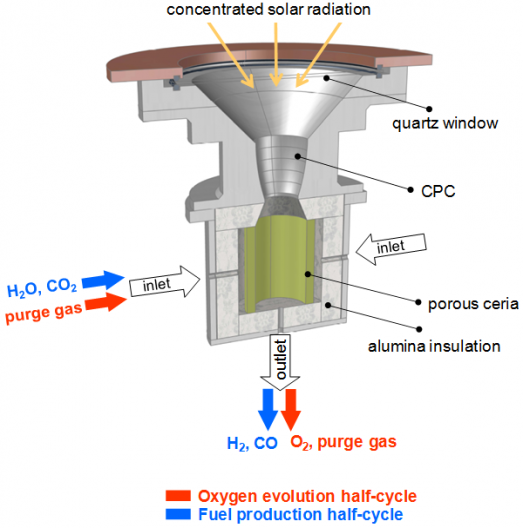"Solar" jet fuel created from water and carbon dioxide
May 1, 2014
The solar reactor that was used to turn water and CO2 into jet fuel
In a move that could help address our insatiable thirst for fuel while at the same time help cut CO2 emissions, scientists with the SOLAR-JET (Solar chemical reactor demonstration and Optimization for Long-term Availability of Renewable Jet fuel) project have recently shown that through a multi-step process, concentrated sunlight can be used to convert carbon dioxide into kerosene, which can then be used as jet fuel.
"Increasing environmental and supply security issues are leading the aviation sector to seek alternative fuels which can be used interchangeably with today’s jet fuel, so-called drop-in solutions," says Dr. Andreas Sizmann, the project coordinator at Bauhaus Luftfahrt. "With this first-ever proof-of-concept for 'solar' kerosene, the SOLAR-JET project has made a major step towards truly sustainable fuels with virtually unlimited feedstocks in the future."
How it works
Although in an early stage of development, the process uses a solar-driven redox cycle with metal-oxide based materials at high temperatures to rearrange electrons, converting carbon dioxide and water into hydrogen and carbon monoxide, also known as synthesis gas (syngas).
“The solar reactor technology features enhanced radiative heat transfer and fast reaction kinetics, which are crucial for maximizing the solar-to-fuel energy conversion efficiency,” says Professor Aldo Steinfeld, leading the fundamental research and development of the solar reactor at ETH Zürich.
The process is then completed using the Fischer-Tropsch process, which is already approved to create fuel for commercial aviation and is used worldwide by companies such as Shell. Developed in 1925, the process takes the hydrogen and carbon monoxide from the syngas, and creates kerosene in liquid form, making it relatively simple to transport.
The impact
"This is potentially a very interesting novel pathway to liquid hydrocarbon fuels using focused solar power," says Professor Hans Geerlings at Shell. “Although the individual steps of the process have previously been demonstrated at various scales, no attempt had been made previously to integrate the end-to-end system. We look forward to working with the project partners to drive forward research and development in the next phase of the project on such an ambitious emerging technology.”
The next phase of the project will require the partners to determine the potential to implement the technology on an industrial scale. At this point, a glass of fuel has been created in a lab with simulated sunlight. It will take significant research and testing to determine if the technology can scale up and remain both cost and energy efficient. This evaluation is expected to be completed in 2015.
"This technology means we might one day produce cleaner and plentiful fuel for planes, cars and other forms of transport," says Máire Geoghegan-Quinn, European Commissioner for Research, Innovation and Science. "This could greatly increase energy security and turn one of the main greenhouse gases responsible for global warming into a useful resource."
Sources: ETH Zurich, European Union, SOLAR-JET
Copyright © gizmag 2003 - 2014 To subscribe or visit go to: http://www.gizmag.com
http://www.gizmag.com/sunlight-carbon-dioxide-jet-fuel/31872
